The Beatles in Minnesota
The Beatles came to town on August 21, 1965, and had a terrible time.
PRELUDE
1964
The band took the Colonies by storm when they first appeared on the Ed Sullivan Show on February 9, 1964. The performance was seen by a then-record 73 million viewers. They performed five songs.
Their second appearance on the Sullivan Show was on February 16, where they performed six songs from the Hotel Deauville in Miami Beach.
Their third appearance was on February 23, 1964, which had actually been taped on February 9, before their live appearance that same day. They performed three songs.
Soon after the band had blown away Americans on the first Sullivan Show, they hit the road in the Colonies. On March 14 and 15, 1964, we were able to see their first American concert, which took place in Washington, DC on February 11. It was shown to local viewers over closed circuit TV at the Minneapolis and St. Paul Armories.

Minneapolis Tribune, March 2, 1964
Thanks to Barb Frost for posting the images below on Facebook:
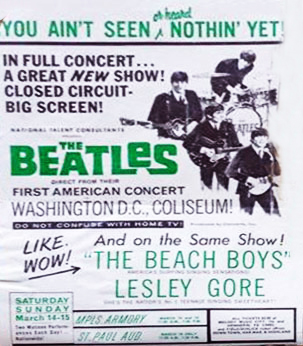
Image courtesy Barb Frost

BEATLEMANIA
It didn’t take long for Beatlemania to take hold in America. Shockingly soon, in February 1964, Baskin Robbins came out with Beatle Nut Ice Cream!
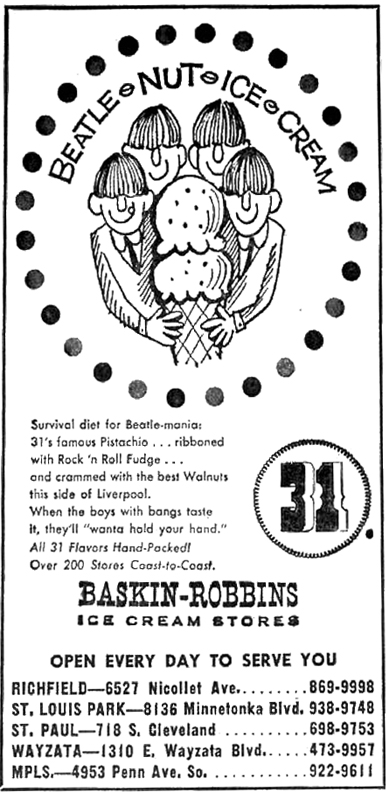
Minneapolis Star, February 27, 1964
Beatle fashions were also in vogue, with turtlenecks (available at Dayton’s), Beatle Boots, and of course, Beatle haircuts. Beatle wigs were actually popular, since some boys couldn’t wear their long hair at their jobs or at school. In a Will Jones column in April 1964, Keely Smith, who was in town to tape an Ed Sullivan show, complained that Keely Smith wigs were being retooled as Beatle wigs.
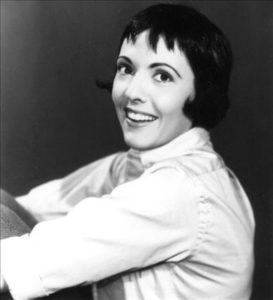
Keely Smith. Not exactly Beatle hair.
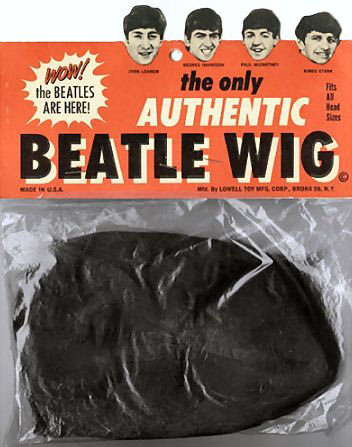
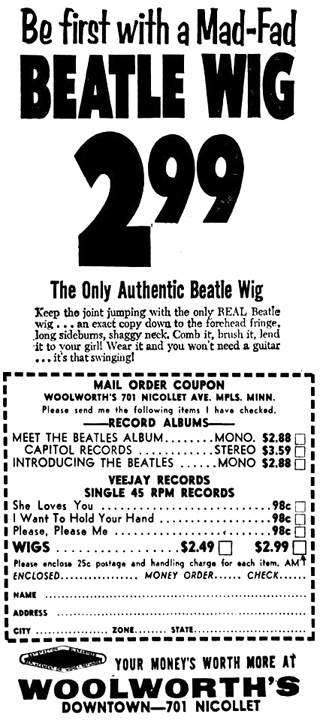
Minneapolis Star, February 20, 1964
After seeing the girls screaming, hundreds of Minnesota boys headed straight to the music stores to buy guitars, and scores of Minnesota rock bands were formed.
THE TOP FIVE
On April 4, 1964, The Fab Four held the top five spots on the Billboard Hot 100 chart, a feat that has never been equaled. “Can’t Buy Me Love” hit No. 1, while “Twist and Shout,” “She Loves You,” “I Want To Hold Your Hand” and “Please Please Me” round out the top five. In all, they had 12 spots on the charts that week. Plus, thanks to “I Want to Hold Your Hand,” “She Loves You” and “Can’t Buy Me Love,” the Beatles are the only act in the Billboard Hot 100’s history to have three consecutive No. 1 hits. Hot doesn’t describe it.
THE FEMALE BEATLES
The Tribune‘s Will Jones reported that on May 29, 1964, a group called the Female Beatles would be opening for a week at the Flamingo in St. Paul for a week. On June 7, they would appear at a Beatle Day event at Excelsior Amusement Park. They were coming from the Thunderbird in Las Vegas.
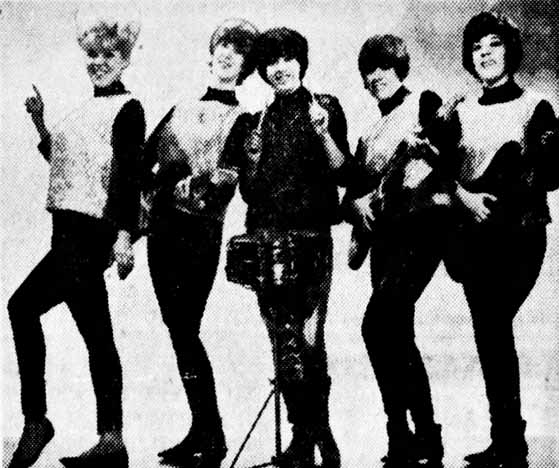
The Female Beatles, Minneapolis Tribune, May 28, 1964
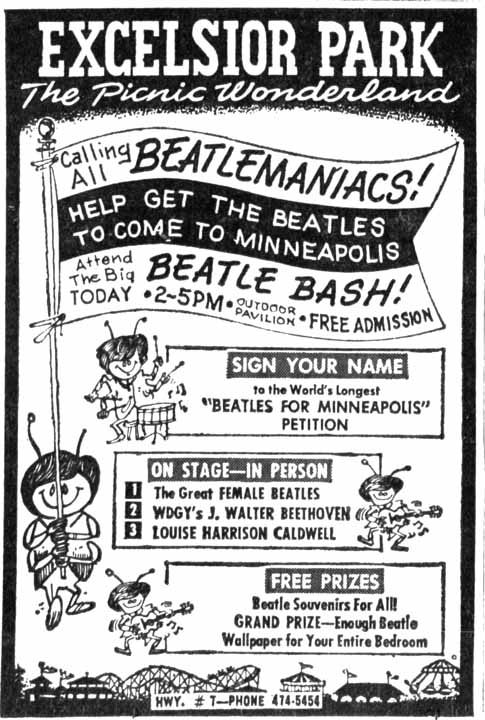
Minneapolis Tribune, June 7, 1964
Gotta wonder who won all that Beatle wallpaper…
BIG REGGIE’S BLUNDER
In April of 1964 [“Big Reggie” (aka Ray Colihan) from Danceland] was offered an opportunity to sponsor an appearance of England’s gift to music appreciation for their August 1964 tour. He grinds his teeth and admits he turned it down “because I didn’t think they’d draw a crowd in August!” By September 1964 he had realized his error and was on a plane for Chicago to try and book them in for this year [1965] at Metropolitan Stadium.
(Ann Graveson in the Minnetonka Record, August 19, 1965)
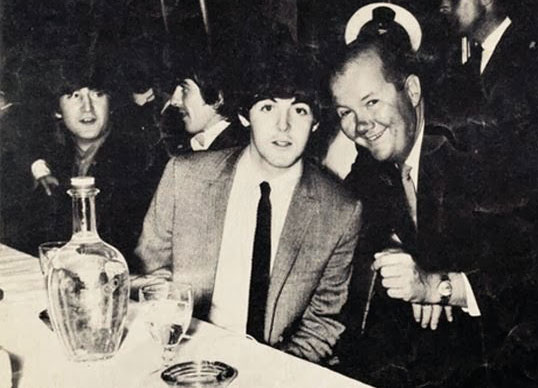
Big Reggie in Chicago, September 5, 1964
Fueling the fire was the opening of “A Hard Day’s Night” on August 7, 1964 at the Orpheum. Below is a ticket to opening day, courtesy of some good soul on Facebook:
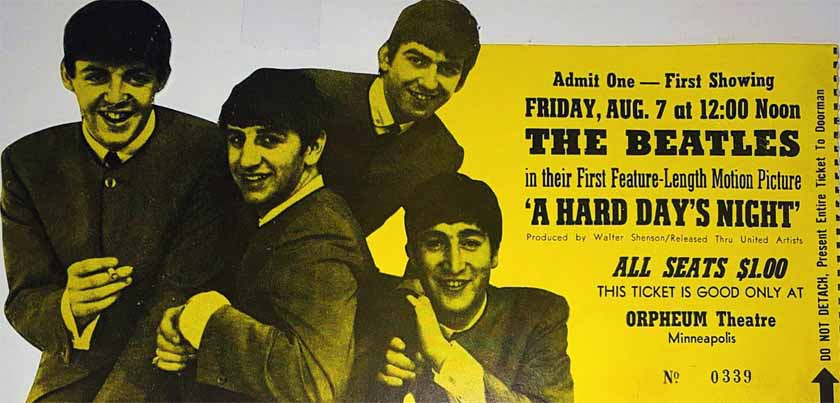
1965
Although Beatlemania was into its second year, it was still very real. Their movie “Help!” was showing at the Orpheum Theaters in Minneapolis and St. Paul, and the album of the same name had just been released. Reggie’s efforts to redeem himself worked, and the concert in Minnesota (Bloomington) was on the Beatles’ 1965 tour schedule.
More of the Minnetonka Record:
There may be nothing left of Ray to watch the fun; for weeks he has been besieged on all sides. Teenage girls (and their parents) write to him for tickets and tips on where to stay; fans have threatened to commit suicide unless he will introduce them to the Mop Tops; his phone rings at the office and at home with dozens of requests, each one more urgent (and sometimes kookier) than the last. …
“Everyone’s asking how we’re doing on tickets and the answer is good” he said Tuesday morning. “I think this is going to have the largest advance sale of any event in the Twin Cities … we estimate about 30,000. Right now i know of about 8,000 out-of-state tickets. There is a sale of 400 in Winnipeg, Canada and requests from Omaha, Denver and Kansas City. Most of these are kids coming with their parents. There’s one group of 350 fans from Chicago who are going to the Beatle show there and then get on buses and be here for another show the next night!”
Another burning question: has the fact that Ringo (drummer) married recently hurt the group’s popularity? Ray says not that he can see. New York sold out at 55,000 and Chicago’s show is already sold out for two performances of 33,000 seats each.
The rumor that Minneapolis is sold out too is adding to Ray’s woes. There definitely are seats available and these will go on sale at the Stadium. But he has been getting calls from out-of-towners who are planning to come and have been panicked by the rumors. …
The final question of how the whole thing turns out rests in the hands of the restless fans. They seem pretty determined… Ray made arrangements with a group of Beatle-lovers to sit in the stands and try and keep their neighbors from screaming. Since word of this was in the paper he has been getting angry phone calls: “We’ll scream if we want to!” He just shrugs and shakes his head. “This kind of action adults don’t know anything about.”
THE SHOW IS ON!
Reggie asked Bill Diehl of WDGY to be the M.C. Diehl went to Chicago to see them in action at their concert before the Minneapolis date and to spend a day and a half with them. He brought back 16 mm film he took of the concert at the Stock Yards Amphitheater.
Hoffbeck (see sources below) says that the concert was heavily advertised on rival rock ‘n’ roll radio stations KDWB and WDGY, one minute each hour for several months. Bill Diehl remembers that Colihan only publicized it by word of mouth and some print, but not on the radio, for fear of pandemonium (which they got anyway). This was the only ad I found in the Minneapolis papers:
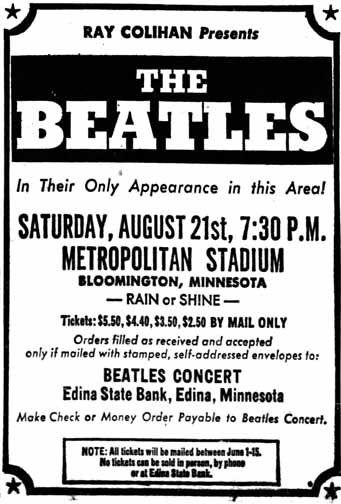
Minneapolis Tribune, May 9, 1965
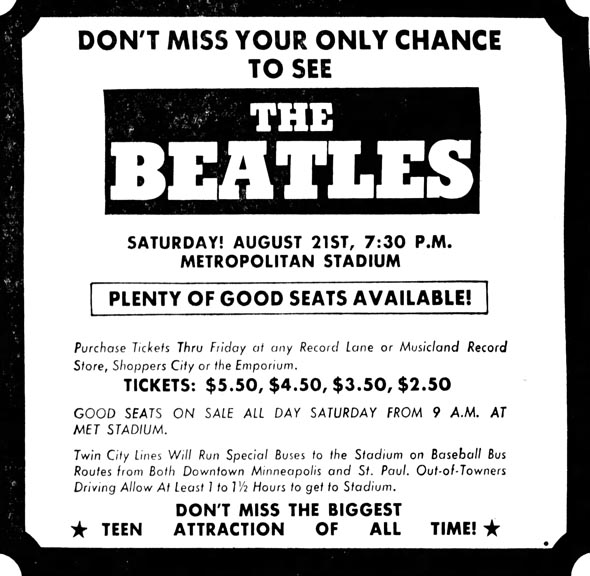
Jon Kowalski found this ad, which was probably in a St. Paul paper.
Tickets were $2.50, $3.50, $4.50 and $5.50. The group received a guarantee of $50,000 and an additional 65 percent of sales above 18,500 tickets. 30,000 tickets were sold, earning Colihan a profit even though the 40,000-seat stadium was not sold out, the only non-sellout on the tour. (Was the fee delivered in cash at the last minute in a Red Owl grocery bag?)
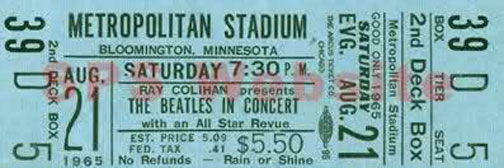
ARRIVAL
Things didn’t start well when they were attacked at the airport by 3-4,000 crazed fans when they got off their chartered plane at 4:15 pm. Ringo was the first off the plane and a fan pushed through the cyclone fence and yanked at him. Paul may have been accosted as well. Plans for some picture taking were abandoned and they barely got into their car before the mob escaped the 60 Bloomington policemen. A blogger says that Pete Heckman picked them up from the airport and took them directly to the stadium. Pete also drove them back to the airport the next day.
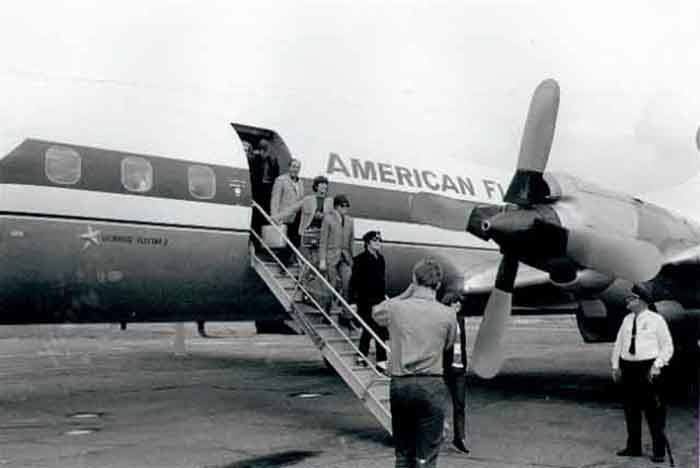
Image courtesy Minnesota Historical Society
The photo below was pulled off of Facebook, and I have no attribution for it. If it is your photo, please contact me so I can credit you.
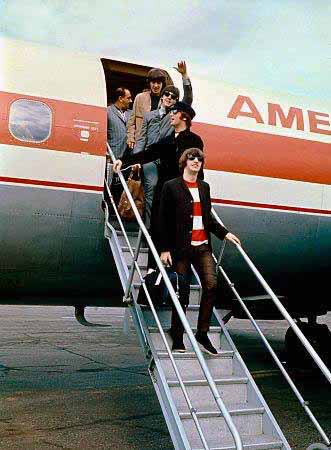
Two men stand-by with a fire hose at Wold-Chamberlain Field in case Beatles fans get out of control. August 21, 1965. Thanks to Michael Larkin!
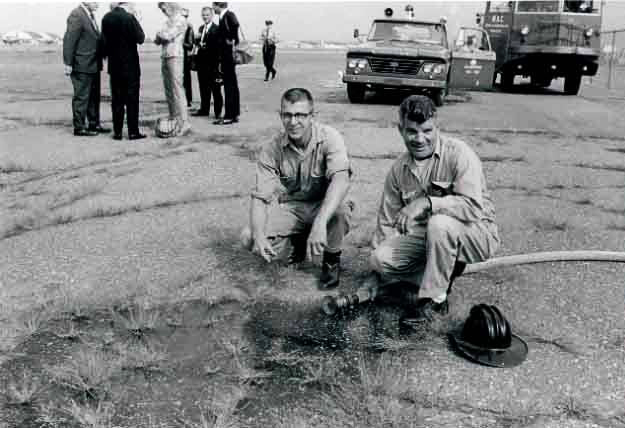
Photo by St. Paul Dispatch, courtesy Minnesota Historical Society
THE LOCKER ROOM
They waited for the show to go on in the Twins’ locker room at the Met Stadium. Ray Crump, the Minnesota Twins Equipment Manager, was with them. (See more on Crump at the end of this page.)
Reported activities included:
- Dining on salad, roast beef, mashed potatoes, green beans, and milk – Diehl later retrieved the dirty dishes and gave them away in a contest.
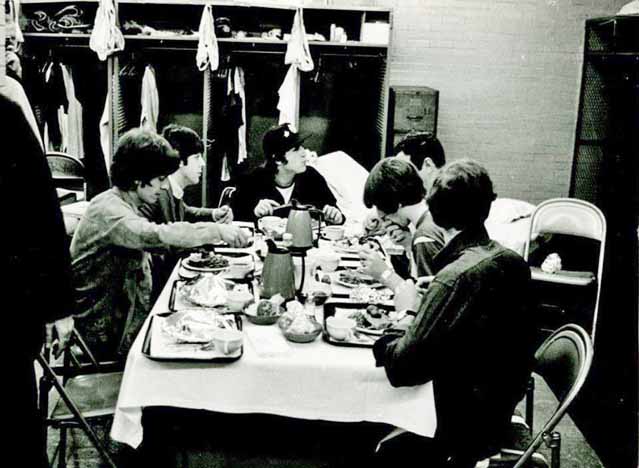
This photo was pulled off of Facebook, and I have no attribution for it. If it is yours, please contact me so I can credit you.
- Lounging on cots – Crump later sold the sheets to an ad agency for $800. The sheets were eventually cut up and given away in drawings at Dayton’s
- Ringo sat in Harmon Killebrew’s chair.
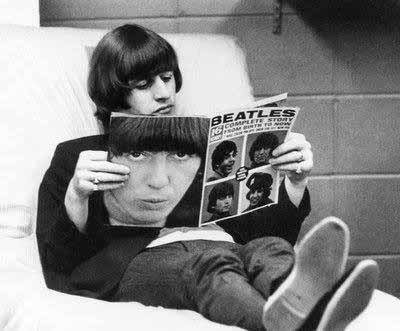
This photo was pulled off of Facebook, and I have no attribution for it. If it is yours, please contact me so I can credit you.
- Paul played guitar in a corner.
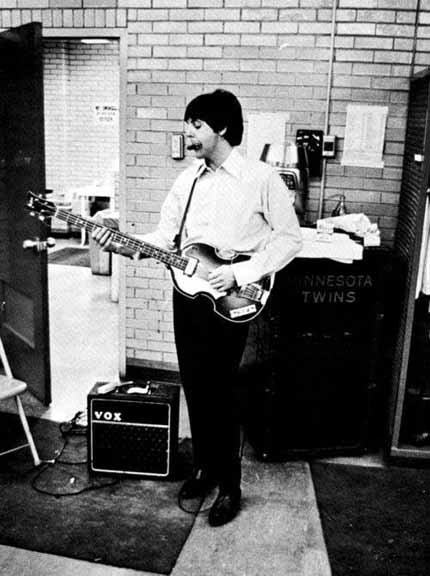
This photo was pulled off of Facebook, and I have no attribution for it. If it is yours, please contact me so I can credit you.
- John Lennon watched a wrestling match on TV.
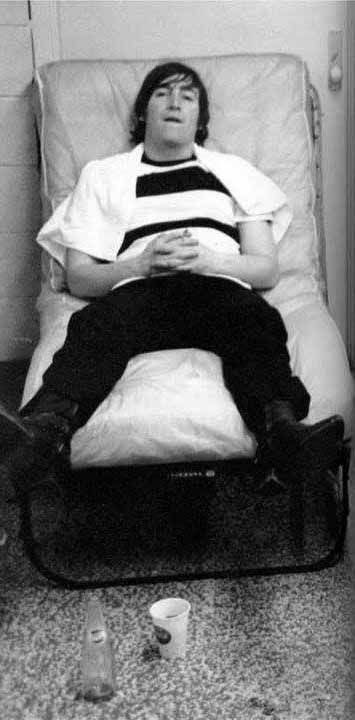
This photo was pulled off of Facebook, and I have no attribution for it. If it is yours, please contact me so I can credit you.
- Taking a sauna for the first time, according to Crump.
- Playing roulette with Brian Epstein to see who would keep the money from sales of souvenir programs. Crump said that after 45 minutes whoever won “took all the loot.”
- Crump also said that the boys were very businesslike backstage, unlike their public personae. “It reminded me of [pro]wrestlers being different on camera and off.”
RAY CRUMP PHOTOS
The photos of Ringo, John, Paul, and George with Ray Crump below were posted on the Old Minneapolis Facebook page by Jill Griffith, Crump’s daughter.
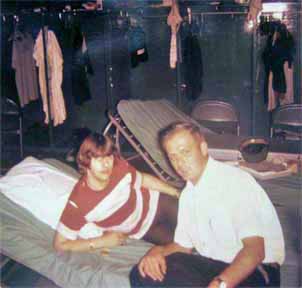
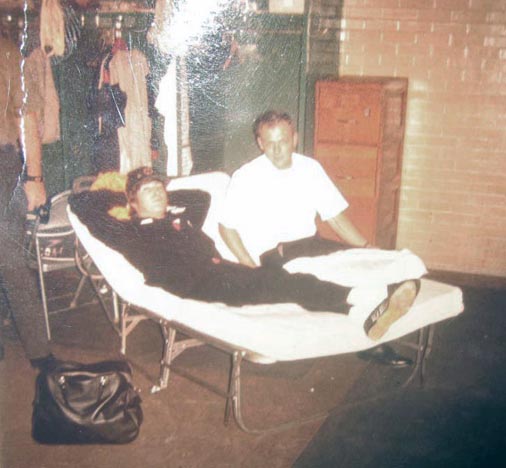
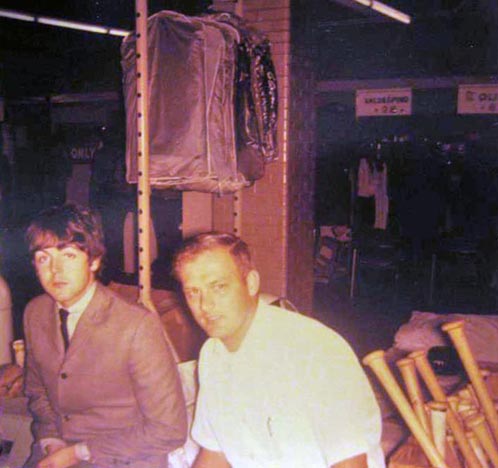
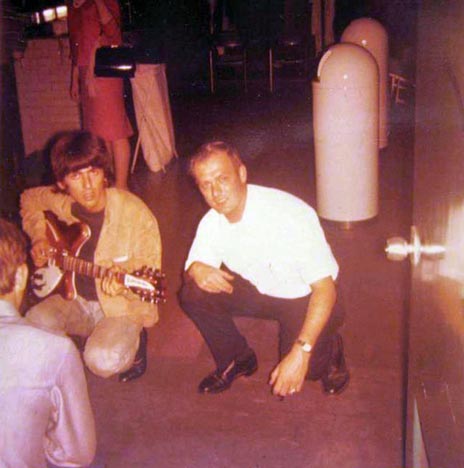
PRESS CONFERENCE
Before the concert, the Fab Four held a press conference in the Minnesota Room of the stadium. Don Powell was the Press Coordinator, in charge of keeping out teenagers!

Courtesy Don Powell
Facing the Beatles were 12 microphones, 5 TV cameras, 150 reporters, and a few teenage “observers” who had won a contest. Most of the questions were silly but then so were most of the answers. Somehow they kept coming back to their hair.
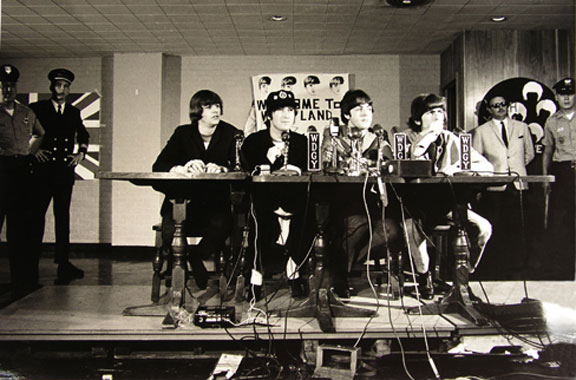
Fred Anderson reveals how a picture of the Beatles at the press conference with the second issue of Twin City a’ GoGo ended up on the cover of the third issue: a’ Go Go editor Bruce Goldstein made arrangements with Big Reggie to put copies of Issue #2 on the tables. The cover of #2 had pictures of the individual Beatles, and the mop-tops (except Ringo) looked at the magazines and played with them and such. The photo on the cover of issue #3 of the magazine was of the Beatles with Issue #2. The picture was taken by Kent Kobersteen of the Minneapolis Tribune. Fred (who worked as a copy boy there) made a print of the negative and slipped it to Bruce.
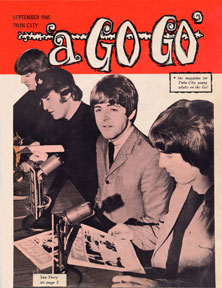
Bill Carlson (not the broadcaster) was a high school student in 1965, working with Merle Morris, a stringer for UPI. When none of Morris’ regular photographers took an interest in seeing the Beatles, Carlson got a press pass and took hundreds of photos that day with his Hasselblad and Nikon cameras. The photos were forgotten until 2007 when Carlson published them in a hardcover book called The Beatles!: A One Night Stand in the Heartland, which is available on Amazon.
The photo below was pulled off of Facebook, and I have no attribution for it. If it is your photo, please contact me so I can credit you.
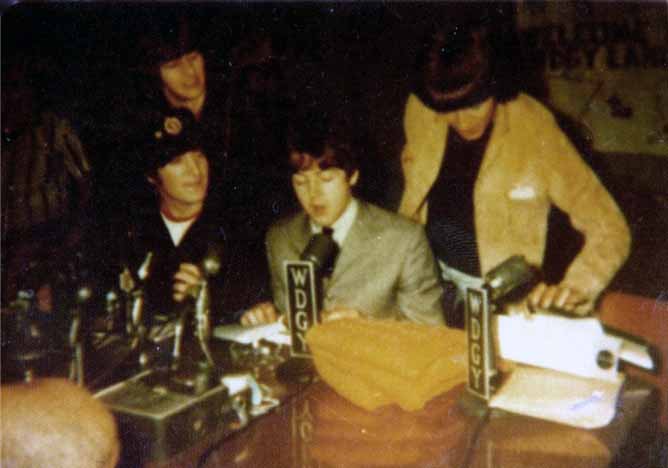
RICKENBACKER PRESENTATION
At the press conference, Randy Resnick, local musician and B-Sharp Music employee, presented a Rickenbacker 360-12 electric 12-string guitar in a Fireglo red sunburst finish to George Harrison on behalf of the musicians of Minnesota. Resnick, pictured below, made the presentation, as captured by photographer Bill Carlson. Ron Butwin, another employee of B-Sharp, was also there for the presentation. They give slightly different accounts of how the presentation came to be.
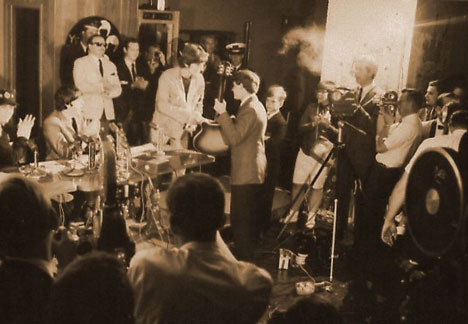
Google Images
In August, 1965, I had an idea: promote the music store where I worked by giving George Harrison, not the key to the city of Minneapolis, but the key to a guitar case, a Rickenbaker 12-string. James Lopes, the owner of B-Sharp Music, liked the idea, so I set about contacting radio stations, because that’s how we’d get the publicity machine started, in the pre-Internet era. After a lot of calling and approaching radio personalities at gigs, I finally got myself a slot at the press conference. We kept one of the keys to George’s guitar case to give away on WDGY after the concert.
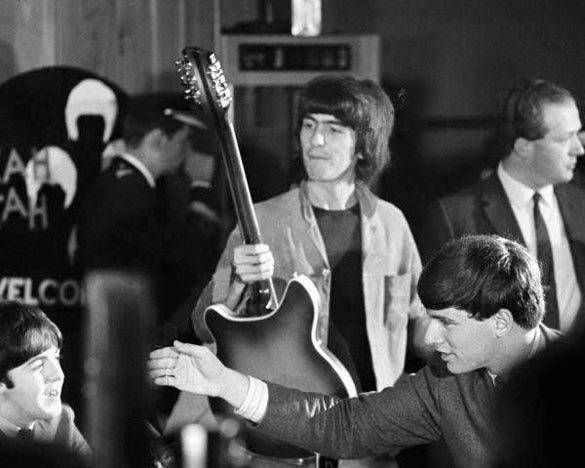
Randy Resnick shakes hands with Paul
Ron Butwin writes:
When the Remo Four – another English group – were in town a few weeks back [Randy Resnick and I] showed them the guitar when they visited our store, and they flipped over it. The group knew the Beatles, and one of the fellows said that George Harrison would love to have a guitar like this. I decided that Randy and I should present it to him when he came to town, with our thanks to the Beatles for causing the guitar business to boom.
An edited version of the press conference is on YouTube (although it occasionally gets taken down); it was clearly Randy who presented the guitar and shook the hands of all four Beatles, although Ron is apparently right there as well.
George was genuinely touched and used the guitar during the show, but it disappeared a year later after their last concert in Candlestick Park in San Francisco. [Another account says the guitar was not used on the US tour, but Harrison played it on “If I Needed Someone” on 1965’s “Rubber Soul.”]
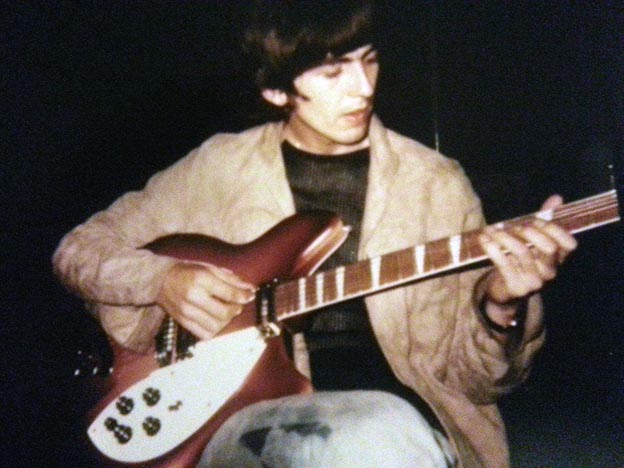
George with Rickenbacker – Image courtesy Jon Kyllo
In a letter dated 7 September, 1965, George expressed his appreciation in a letter to Butwin:
I cannot tell you how much I appreciated your generosity in giving me such an expensive guitar when we were in Minneapolis. As you know, I did have the older model, but I’ll definitely be using the new one in the future, both for recording sessions and stage appearances.
IN THE CONCOURSE
Local groups the Accents, Underbeats, TC Atlantic, and Gregory Dee and the Avanties played in the concourse of the stadium before the show. Rod Eaton of the Underbeats explains:
In those days the Minneapolis Musicians Association – the “union” – demanded “minimums” on many venues. So Reggie needed to hire a bunch of bands to meet the union minimum for the Met. But the Beatles wouldn’t allow local groups to play on their stage. The upshot of all of this is that the Underbeats and several other Twin Cities bands were asked to play in the concourse surrounding the stadium before the actual concert. None of us were happy with the arrangement – we felt it was sort of demeaning. But because it was Reggie asking we agreed. In exchange we were all given really great seats for the show.
Here’s the thing – I don’t remember playing there at all. In fact for a long time I was convinced the Underbeats didn’t play that night. But since everyone tells me we did I have to agree – it must have happened. I just don’t remember any of it. I do remember Pat and me being at the concert. I remember there was a lot of screaming and the Beatles were hard to hear. I remember they didn’t sound all that good – partly due to the noise and partly due to tired voices. And I remember listening to T. C. Atlantic play in the concourse. I’d heard a lot about the group but hadn’t had an opportunity to hear them. A year later I was their drummer.
(hear more about the experience of the Underbeats at the Beatles concert in an interview.)
THE SHOW
The show started at 7:30. Opening acts on the tour were Brenda Holloway and the King Curtis Band, and Cannibal & The Headhunters. Sounds Incorporated (not to be confused with Sounds Orchestral), was another British group managed by Brian Epstein. They had no hits but had appeared in a couple of films; their thing was apparently putting the classics to a rock beat.
The Beatles ran out of the dugout to the elevated stage at the pitcher’s mound. Enduring terrible acoustics, the lads sang 11 songs in 35 minutes. “Twist and Shout” was deleted because John had throat problems.
- She’s A Woman
- I Feel Fine
- Dizzy Miss Lizzy
- Ticket To Ride
- Everybody’s Trying To Be My Baby
- Can’t Buy Me Love
- Baby’s In Black
- I Wanna Be Your Man
- A Hard Day’s Night
- Help!
- I’m Down
There is a bronze plaque at the Mall of America at the spot where they played – home plate of the old stadium. It’s embedded in the floor in the northwest corner of Nickelodeon Universe, about 40 yards from where the closest fan would have been. Security guards and ushers were armed with smelling salts for fainting fans. The number of police has been estimated as up to 350 and came from Bloomington and Hennepin and Ramsey Counties. Reports conflict as to whether the concert had to be cut short when fans rushed the field. Hoffbeck says that one fan broke free and went running but was intercepted by police and hurled back over the fence.
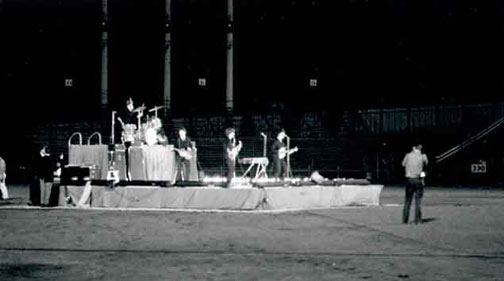
Photo courtesy Minnesota Historical Society
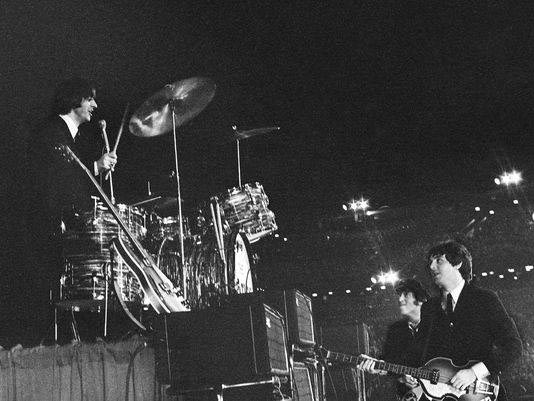
Image courtesy Minnesota Historical Society
The photo below was pulled off of Facebook, and I have no attribution for it. If it is your photo, please contact me so I can credit you.
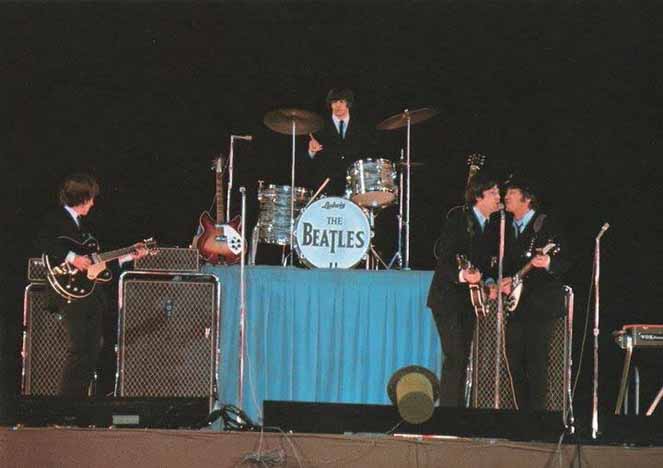
The photo below was pulled off of Facebook, and I have no attribution for it. If it is your photo, please contact me so I can credit you.
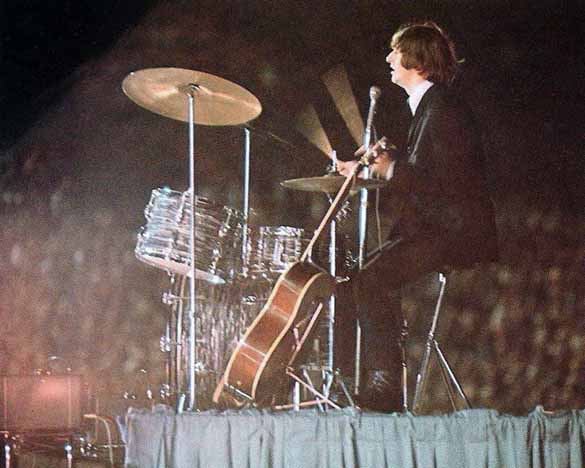
A typical Beatles exit was made with a decoy limo and a real escape in a Falconers’ laundry van (they sat on folding chairs).
RADIO STATION HI-JINKS
Rock stations WDGY and KDWB were in mortal competition during these years, and did everything in their power to associate themselves with the Beatles. Stories told by Bill Diehl, head DJ at WDGY and Sam Sherwood, General Manager of KDWB, were very different, as can be expected. I was privileged to be able to interview each of them before their passing, and hope I asked the right questions!
Sherwood said that he met the Beatles in New York back in 1964 when they were in town to appear on the Ed Sullivan Show. He hung out with them at the Plaza Hotel and secured a phone line to the room. He called Lou Riegert back at the station in Minneapolis and Lou interviewed the boys on the air. Sam also somehow (he wouldn’t say) surreptitiously obtained an acetate of each new Beatles song from a secret source in New York, hid it in his desk, and when he got the go-ahead, he transferred it to disk and put it on the air. Over the record the DJ would announce “This is a KDWB exclusive” so nobody could tape it and use it on another station. Sam said he was successful with this on all the records except for the German version of “I Wanna Hold Your Hand.”
In 1965, when Big Reggie made the deal for the Beatles to come to Minneapolis, Sherwood said that he went to Chicago and met with the “real promoter.” He was told that WDGY had a lock on it, sponsoring the press conference and emceeing the show. That decision was confirmed by Capitol Records branch manager Paul Goetz. Sherwood implored Goetz to let him participate in introducing the band. Goetz asked Diehl if Sherwood could be a part of the introduction, and Diehl said no. Sherwood told Goetz that if he couldn’t be on the stage for the introduction, KDWB would never play any Beatles songs again. Diehl said that the rep asked him if Sherwood could be on the stage as well to introduce the Fab Four, but Diehl told him that the Beatles insisted that the emcee be a member of the American Guild of Variety Artists (the performer’s union), which Sherwood was not. It went back and forth, and finally Diehl relented and allowed Sherwood to be on the stage for a brief moment.
Sherwood said that KDWB got the limo concession, with mobile phones so the boys could talk to the DJs while in transit to Met Stadium.
LOUISE HARRISON CALDWELL
Into the fray came George Harrison’s sister, Louise Harrison Caldwell. Louise had moved to the United States in the 1950s, and before becoming famous, George had come to the States to visit her. When Beatlemania hit and the group came to tour the U.S., George was the only one who had been here before.
It is likely that Louise was at the 1964 concert in Chicago, and that she met Bill Diehl there. When the Beatles came to Minnesota in 1965, Diehl invited her to come and visit, and put her up at the Thunderbird Motel, where they all went swimming. During her week’s stay, she agreed to accompany Bill to dances that he emceed, for a fee to be paid by the venue. Sometimes they would decline, but most times they would pay to have her there. The kids loved to talk to her and get her autograph, Bill remembered.
Sherwood said that KDWB was supposed to get the press conference, but because of Diehl’s friendship with Caldwell, Diehl got exclusive coverage, with the conference broadcast on WDGY, WDGY flags on all the microphones, and a “Welcome to WDGY Land” banner behind the table. Diehl said that Caldwell had nothing to do with that, and that WDGY had the press conference rights because of the agreement with Colihan.
Sherwood retaliated by telling his reporters to take all the front spots and prefacing their questions with “KDWB wants to know…” When one question didn’t start out that way, Lennon asked, “Wait a minute, doesn’t KDWB want to know?” Diehl said that someone from KDWB grabbed the line at a nearby phone booth in order to broadcast the press conference, but WDGY put two guys nearby to intone “WDGY is Number 1” and that was that.
Bill Diehl got the honor of introducing the stars of the show, prefaced with a warning that the show would be stopped if the fans rushed the stage (met with major boos). Beatles management had a lot of rules, including one that the emcee was not to tell corny jokes before the introductions. Bill faked them out with his introduction: “A funny thing happened to me on the way to the show…. THE BEATLES!!”
But Sherwood had another trick up his sleeve. To create a “headline event,” he hired a helicopter with a banner that said “KDWB Welcomes the Beatles.” The concert started, and he waited and waited and the thing didn’t come, and it was getting dark, and finally there it was, buzzing the stadium. John Lennon used his guitar to shoot at the helicopter, and Sherwood got a huge kick out of the stunt. Nobody has turned up any photos of the helicopter so far.
Another Minneapolis-related tidbit about Louise Caldwell was that in 1964, a record was made of interviews she gave with disc jockeys from five cities (none from Minnesota). The record, “All About the Beatles,” was issued – at least here – on Recar Records, a polka and country label started by George Garrett. An unopened copy, complete with a card you could mail in for a Beatles photo album, was recently for sale for $250. (Recar LP 2012)
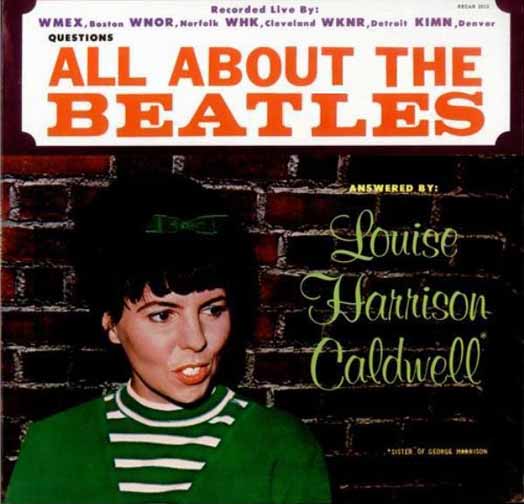
Image from Discogs.com
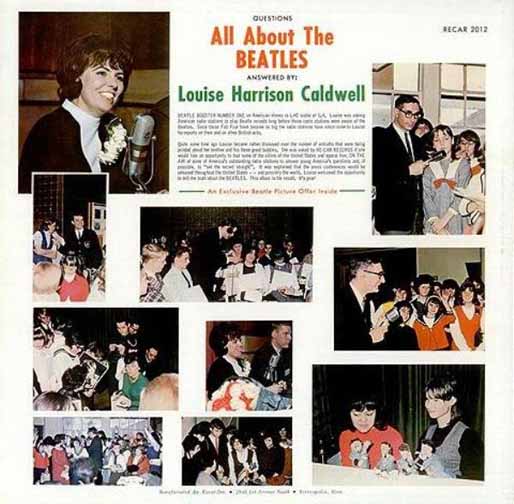
Image from Discogs.com
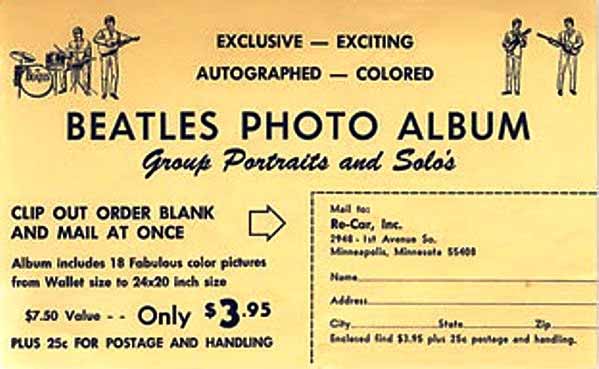
Image from Discogs.com
THE LEAMINGTON MOTOR LODGE
Their not-so-luxurious accommodations were the entire 5th floor of the Leamington Motor Lodge (not the hotel) at 4th Ave. and 10th Street in downtown Minneapolis. Built in 1962, it would have been relatively new in 1965, but it was still a “motel” and not proper digs for our heroes. Decoys were set up at much better billets, but word got out and the place was mobbed with girls trying to get in. Bill Diehl remembered “grown women” climbing up downspouts on the outside of the building trying to get in, with cops pulling them down.
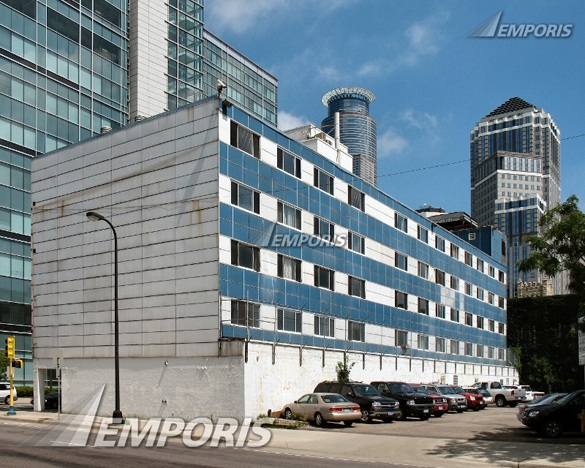
The Leamington Motor Lodge, many years later
Police Inspector Donald R. Dwyer did not mince words expressing his disdain for the mop tops, calling them a “typical traveling troupe,” akin to circus performers. He claimed he’d found a girl in Paul’s room and charged him with making a “false hotel reservation.” Fortunately, the girl was able to prove that she was 21 (and from Cleveland). Dwyer told the Minneapolis Star that “Those people are the worst I have ever seen visit this city,” and in a press conference said “if they did not come [back] it would be too soon for me.”
But Diehl said that he was up there with the Beatles, and that there was no way that, with all the money invested in them, that Brian Epstein would allow them to be involved with the scandal of having girls in their rooms, and that the police lied about what went on. Diehl said that the whole thing was blown completely out of proportion, and when the Beatles said they’d never come back to Minneapolis, Diehl said he didn’t blame them. (McCartney did return, though, on June 4, 1976, with his band Wings. The show at the St. Paul Civic Center did sell out.)
The photo below may have been taken at the infamous LML. In it we see the Beatles with various radio station personalities, including Johnny Canton.
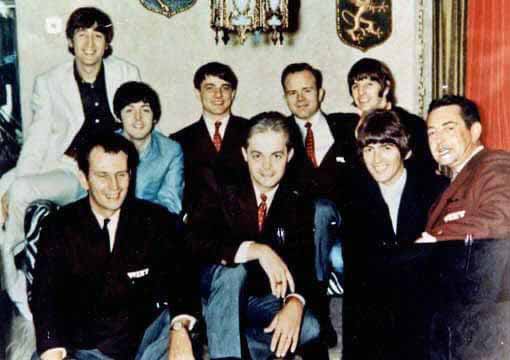
From the personal collection of Johnny Canton
The Leamington Motor Lodge, saturated with the stale cigarette smoke of thousands of traveling salesmen, was mercifully demolished in February 2008, after being used as a homeless shelter in the 1990s.
ESCAPE FROM MINNESOTA
The group emerged from the motel at 11 the next morning. As their chartered Electra airplane headed to Portland, Oregon, one of its engines caught fire while on automatic pilot – apparently the human being pilots were busy Meeting the Beatles. The plane made it to Portland and was replaced by a Constellation aircraft for the rest of the tour. The Electra later crashed in Oklahoma in 1966.
AFTERMATH
After the concert, Big Reggie was heard to say “Their manager just told me this was the best behaved bunch of kids they had played to yet..”
Correspondent Richard reports that “the next day my friends showed me certificates they had gotten that stated that they had seen the Beatles live at Met Stadium. The format of the certificate was loosely based on the format of a graduation certificate.”
Met Stadium was demolished in 1985, and the Mall of America sits on the site today.
In 1995 KSTP-TV produced a video called “The Beatles: Minnesota Mania!” The video includes an extensive interview of Bill Diehl and members of Minnesota bands from that era. It also includes the footage Diehl took of the Chicago show that immediately preceded the Minnesota appearance. The production is now available on DVD from VideoBeat.
B-Sharp Music burned to the ground in May 2005, destroying autographed photos of the Beatles.
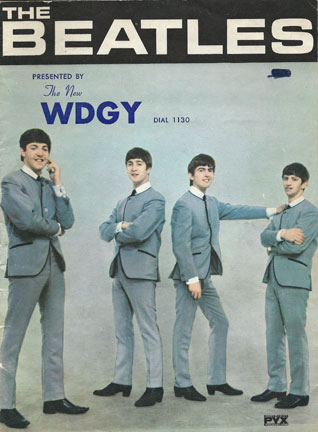
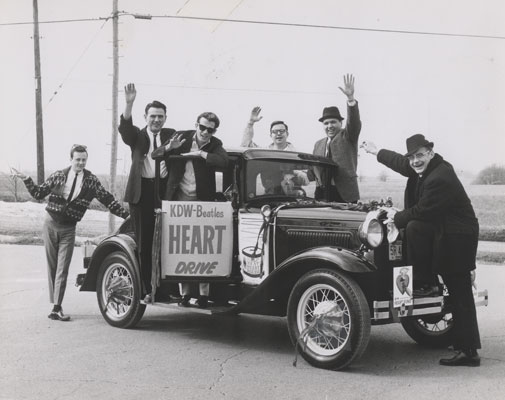
Lou Riegert, James Frances Patrick O’Neill, Don Bowman, Charlee Brown, Sam Sherwood, & Car Owner. Photo courtesy Sam Sherwood
DON’T BE FOOLED
In 1979, Melvin Records released a bootleg EP entitled Visit To Minneapolis, which claimed to contain three songs and the press conference from The Beatles’ 1965 Minneapolis concert. Closer inspection proved them to be excerpts of the Houston performance on August 19, 1965. One giveaway is that the record included the song “Twist and Shout,” which the band didn’t do in Minneapolis because John was having throat problems.
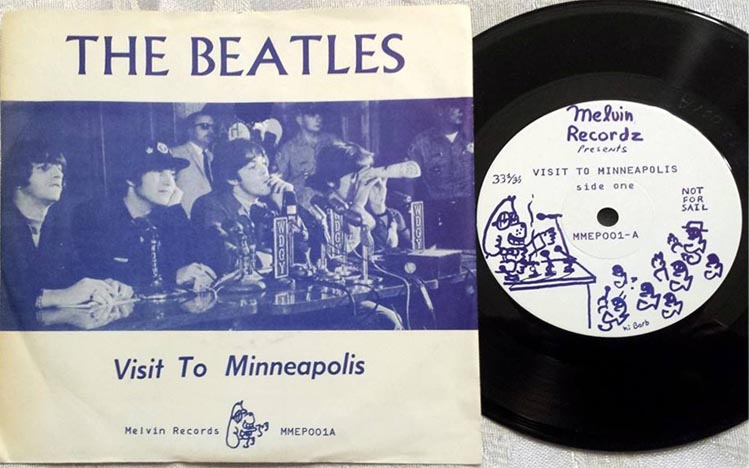
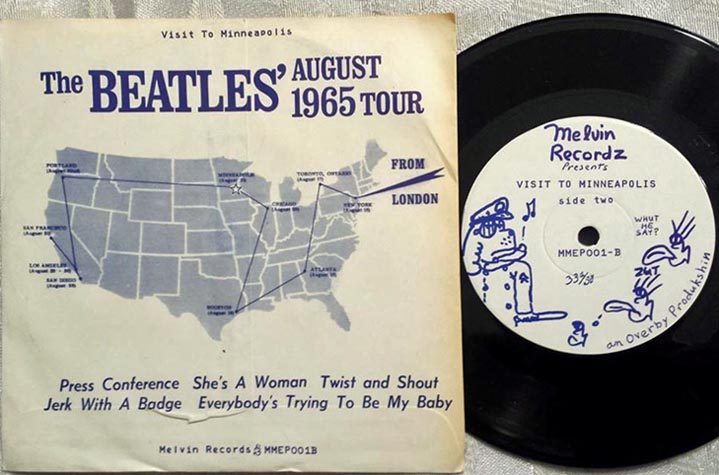
50th ANNIVERSARY
Here’s an article that came out in 2015 about the 50th Anniversary of the concert:
Remembering the Beatles’ concert at the old Met
By Mike Hanks, Sun Current. Published August 26, 2015 at 10:16 am
After five decades, the stories are nearly as legendary as the Fab Four.
Aug. 21 marked the 50th anniversary of the only concert the Beatles performed in Minnesota. The concert, held at Bloomington’s former sports stadium, has provided many famous tales in Minnesota folklore. And plenty of those whose names are attached to the tales are still alive five decades later to share them.
The concert attracted Beatles fans, many female, from around the Twin Cities, and beyond. One of the most famous tales from the concert, however, belonged to a man who had little interest in the lads from Liverpool, and he had no idea he’d have a chance to meet them on Aug. 21, 1965. Never in his wildest dreams did he think he’d spend eight hours of his day hanging out with them as they quietly whiled away the hours prior to their short performance on the field of the former Metropolitan Stadium, now the site of Mall of America.
Ray Crump of Bloomington was 29 years old when Beatlemania swept through Minnesota. Crump knew who they were, but he wasn’t much fascinated by the music or the band that had many teenage girls swooning. Crump was a country music fan. “I didn’t know a whole lot about them,” he said.
Crump’s brush with the Fab Four came because he worked for the Minnesota Twins as the team’s equipment manager. Crump didn’t travel with the team, and he went to the stadium that day to take care of baseball-related business, never expecting to cross paths with John, Paul, George or Ringo.
The band was using the visiting team’s locker room as its headquarters that day, at least that was the plan. When Crump crossed paths with Beatles manager Brian Epstein, however, a deal was struck to open up the home team’s clubhouse for the band, on one condition: Crump would be there at all times. Although the Twins were on the road, team equipment and personal property of the players – stored in their lockers – remained in the clubhouse. Crump was the gatekeeper to all of it and wasn’t about to leave it unattended, he recalled.
Deal struck, Crump would go on to famously spend eight hours with the lads, watching them gamble their shares of the revenue from the day’s program sales and enjoying dinner with them. Crump posed for pictures with each of the band members, and took black-and-white photos of his own as he attended the press conference the band held prior to their performance, at Ringo Starr’s insistence, Crump said.
Crump compares the band to pro wrestlers, the likes of which he had dealt with periodically. Wrestlers were businesslike in the locker room, entertainers in the ring. The Beatles were very similar; they saved their showmanship for public eye, Crump explained.
Crump listened to their show, as best as it could be heard, from a dugout of the stadium. He didn’t know much about them at the start of the day, but by the end of the night he knew “they weren’t going to be a flash in the pan,” he said.
Crump spoke with Starr two years ago. He had contacted Starr, offering to give him copies of his pictures from 1965. Starr called him personally, and remembered the autographed baseball Crump gave to the band, bearing signatures that would soon represent the American League champions. Crump was planning to attend Starr’s concert at Mystic Lake Casino two years ago, but had his leg amputated shortly before the concert and was unable to attend, or present the photos to Starr. He hopes to have a chance to do so this fall when Starr performs in downtown Minneapolis, he noted.
Thousands of fans have stories and memories of the one night the Beatles performed in Minnesota. Many of those stories belong to teenage girls of the 1960s. One of them belongs to Greg Perrine of Conway, Ark., who grew up in Bloomington and worked at the stadium as a 13-year-old.
Perrine was interested in the concert because of all those teenage girls he knew would be attending the show. (By his estimate 80 percent of the fans at the concert were female.) Using his employee badge, Perrine went to the stadium hours before the show and gained entry with his friend Mike. The two spent the afternoon and evening at the stadium, and had perfected a British accent to impress the girls at the concert. It worked, Perrine recalled.
Perrine has vivid memories of several moments from that day. Early in the afternoon he saw a guy signing autographs. The guy looked like Starr, although his hair didn’t appear to be as dark as it did on the album covers of the 1960s, according to Perrine. He saw one of the autographs, and it was signed by Richard Starkey, so Perrine and his friend didn’t think it was Starr. Although the duo was convinced at the time that it wasn’t Starr signing an autograph under his birth name, all these years later Perrine is still not sure whether it was Starr or not.
Perrine doesn’t remember much about the opening acts. The only act he remembers was Cannibal & the Headhunters, as he knew of them from their version of “Land of a Thousand Dances,” he said.
Perrine watched the concert from a camera pit in the upper deck. He borrowed a pair of binoculars from a girl sitting behind him. As he focused in on Paul McCartney, McCartney said “hello” to him as Perrine watched from afar. At least Perrine would like to think so. He suspects thousands of girls experienced a similar moment.
As an opportunistic 13-year-old, Perrine didn’t realize he was going to be part of music history. “It didn’t seem like a historic event,” he said. Although it may not have been the most important night of his young life, it had a profound effect on him, he said. Music has been a part of his life ever since, from performing in garage bands to attending numerous concerts throughout the decades. Nowadays, Perrine can be found in his Arkansas garage in his free time, working on vintage guitars and amplifiers he buys and sells, he explained.
There are thousands of stories from that concert, and Jeanne Andersen of St. Louis Park has collected plenty of them.
Andersen was too young to attend the 1965 concert, but her fascination with the music of the 1950s and ’60 has never waned, and for the past decade she has collected stories about many of the bands that were part of the local music scene back then. Through her chronicling of those stories, she has also dedicated significant time to the Beatles’ performance in Minnesota, which she shares online through her Twin Cities Music Highlights web page.
Andersen’s website illustrates the faded, and differing recollections, of Beatles fans. She has had the fortune of interviewing key figures involved with the promotion of the concert, as well as the two men with differing stories behind the Rickenbacker 360-12 electric 12-string guitar that was presented to George Harrison during the press conference hours before the concert. Andersen’s information about the presentation includes excerpts from emails she received personally from the two men involved in the guitar presentation, and their differing accounts of the incident.
SOURCES
The above information comes from a number of sources, including:
- Interview with Bill Diehl
- Interview with Sam Sherwood
- Article by Jon Bream and Kevin Odegard in the StarTribune
- “Instamatic Memories, The Beatles in Minnesota,” by Steven R. Hoffbeck, Minnesota History Magazine, Spring 2007. Click here to download a pdf of this very well researched article.
